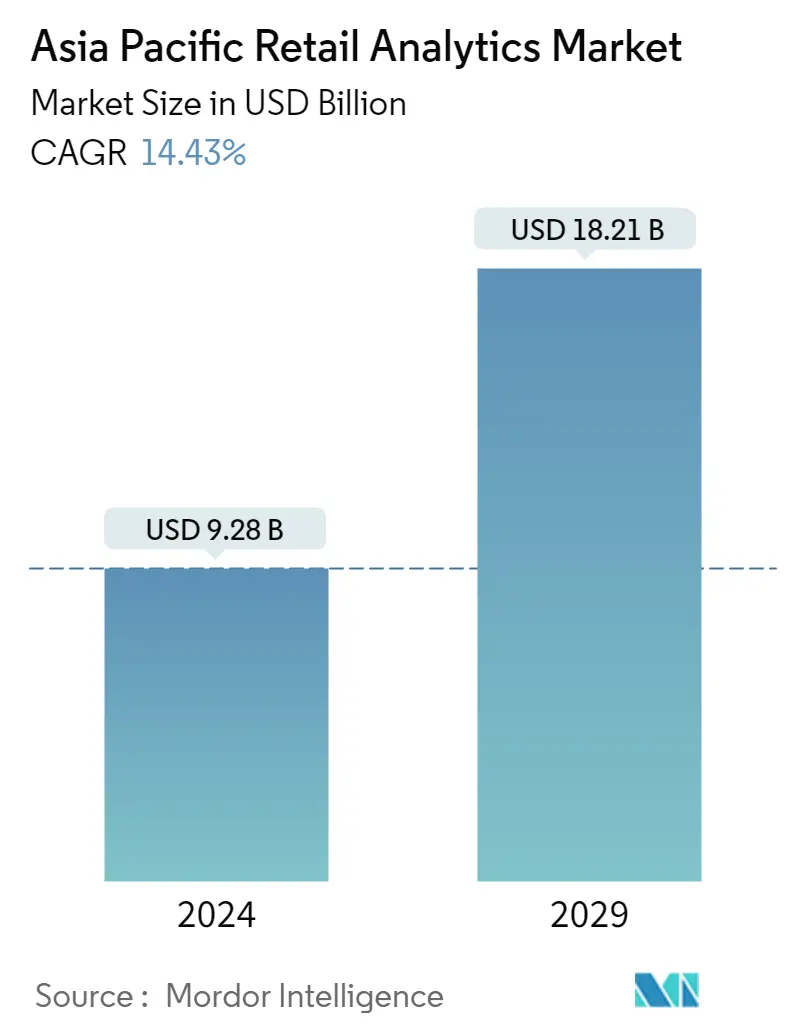Market Size of Asia Pacific Retail Analytics Industry

| Study Period | 2019 - 2029 |
| Base Year For Estimation | 2023 |
| Market Size (2024) | USD 9.28 Billion |
| Market Size (2029) | USD 18.21 Billion |
| CAGR (2024 - 2029) | 14.43 % |
| Market Concentration | Medium |
Major Players.webp)
*Disclaimer: Major Players sorted in no particular order |
Need a report that reflects how COVID-19 has impacted this market and its growth?
APAC Retail Analytics Market Analysis
The Asia Pacific Retail Analytics Market size is estimated at USD 9.28 billion in 2024, and is expected to reach USD 18.21 billion by 2029, growing at a CAGR of 14.43% during the forecast period (2024-2029).
- The market is expanding quickly due to retailers using the Internet of Things more frequently and adopting analytics tools faster.
- Retail analytics provides analytical data on inventory levels, supply chain movement, consumer demand, sales, etc., essential for marketing and procurement decisions. Retail analytics is the analysis of data generated by retail operations to make business decisions that drive profitability. Data analytics on supply and demand can be applied to maintain procurement levels and make marketing decisions.
- This includes offering insights to comprehend and improve the retail business's operational procedures, sales trends, consumer behavior, and overall performance. Because of consumers' high standards for retail today, companies must satisfy these growing demands with tailored omnichannel offers, practical procedures, and prompt adjustments to emerging trends. All of these activities require retail analytics. The market is expected to expand as more retail establishments open in countries such as China, Japan, India, and other developing nations.
- For instance, Reliance Retail announced in February 2023 that it planned to open multiple Gap stores next year with an eye toward the country's mid-premium apparel market. Reliance Retail acquired the rights to sell American casual wear brand Gap in India last year. The retailer plans to open 50 new locations overall in the upcoming year. The opening of such stores will increase demand for retail analytical solutions.
- Analytics can help retailers make better marketing decisions, improve business processes, and provide better overall customer experiences by identifying areas for improvement and optimization. The demand for analytical solutions in the sector is anticipated to increase with the rapid expansion of the retail industry across all countries. For instance, retail sales in Japan rose by 6.6% YoY in February 2023, exceeding market expectations of 5.8% and accelerating from a revised 5% growth in January. Retail trade increased for the 12th month, running the fastest since May 2021.
- Additionally, the retail sector's growing adoption of Industry 4.0 has significantly aided the market's expansion. The market for retail analytics is expanding due to the rising popularity of smartphones and e-commerce. During the forecast period, it is also anticipated that increasing income levels, government spending on big data and analytics, and demand for automated retail-based services will stimulate the regional retail analytics market.
- Retail analytics market growth is significantly constrained by the high capital expenditures required for installation, maintenance, testing, licensing, and other technical labor costs associated with retail analytics tools. Another factor impacting the market is the unorganized retail sectors' limited access to technology and tight budgets.
- As most companies started remote operations to avoid exposing their employees to COVID-19, retail sales dropped, indicating a blockage of sales information to retailers' data repositories. Since the objectives of a specific automated system or predictive model remained the same, the input data and the users' issues led the companies (vendors) to re-evaluate how outputs could now be interpreted and relied upon.
